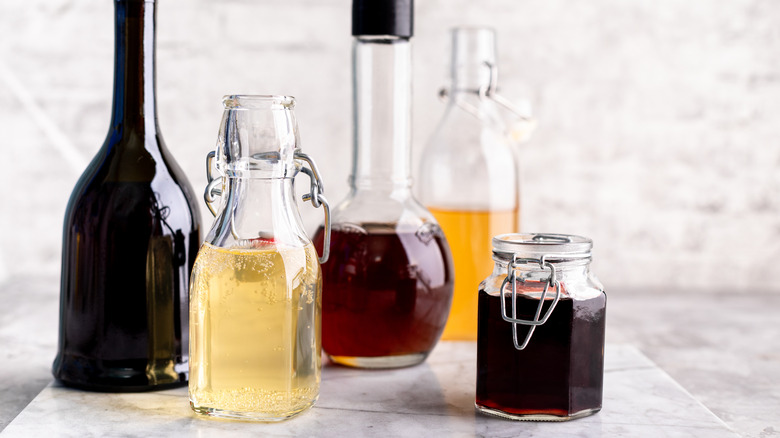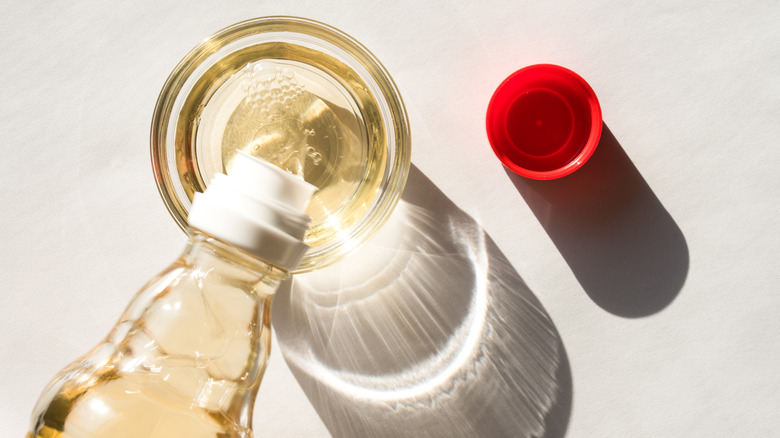White Wine Vinegar Vs Red Wine Vinegar: What's The Difference?
Most of the time, when people talk about their favorite foods, sauces, or snacks, we listen to them rave about sweet chocolate chip cookies, crunchy topped mac & cheese, or their favorite potato chip brands. Still, it feels like one very real, powerful, and delicious flavor gets overlooked, and that is sour. This flavor, according to the "Encyclopedia of Gastroenterology" (via ScienceDirect) developed as a taste to warn us about potentially spoiled food. We even have a strong physical reaction to sour things such as puckering our lips and salivating which protects our tongue from acids. Now, obviously, there are quite a few people who can't stand sour candy or cocktails. But today sour is perceived less as a sign of rotten food but more often used to liven up an otherwise dull dish or drink.
Ingredients that have acidity or sour vinegar flavors are necessary to have in the kitchen. We need them to enrich the flavor of our dishes with something zesty and lively. We rely on lemons and limes to bring acidity to our meals but sometimes we need something with a bit more kick.
What is white wine vinegar?
Vinegar is known for its sour and acidic palate, and can commonly be found in modern recipes. White wine vinegar is made from white wine. Masterclass tells us that it is made from a white wine base, which is a stock that is distilled in stainless steel and creates acetic acid. The acid is then diluted with water, leaving only 5-7% of the acid in the mix. We use white wine vinegar to make a basic vinaigrette for our salad, to marinate our meats, flavor our soup broth. In fact, it is mostly utilized as a popular, inexpensive condiment (via Varvello).
But this vinegar also has a few other uses. It is good for cleaning including removing hard stains. Varvello states that white wine vinegar is all-natural and colorless, meaning that it is good to clean your house without using harsh chemicals. White wine vinegar may also be good for your body. Healthline reports that vinegar has been used medicinally for centuries. Vinegar may help control your blood sugar, make you feel full, and is a good topical treatment for fungus, warts, infections, and burns (though that last one will sting a little). And though wine vinegars are made from fermented wine, you need not be worried about pouring too much onto your food. Wine is fermented and has alcohol in it, but the secondary fermentation process to create wine vinegar allows bacteria to feed on the alcohol and remove it (via The Cookful).
What is red wine vinegar?
If white wine vinegar is made from distilled white wine, then logic would dictate that red wine vinegar is distilled from red wine (via Masterclass). The major difference between the two kinds of vinegar is mainly the color. Red wine vinegar, like white, can even be used as a cleaning product. According to In The Wash, red wine vinegar is particularly good for cleansing glass, floors, and countertops, but warns not to use it on light-colored clothing because of its color.
When it comes to flavor, you might assume that red wine vinegar tastes more like red wine and white wine vinegar tastes a bit more like white wine, and you're not wrong. Bon Appetit describes red wine vinegar as fruity and robust, making it perfect for red meat and hearty or cheesy foods, whereas white wine vinegar tends to be on the lighter side and pairs better with lighter meats and sauces. An easy trick the outlet suggests is to think about what kind of wine you'd want to be paired with your dish and choose the vinegar based on that. But if you only have one kind of vinegar on hand, don't worry. Cooks Illustrated tests conclude that when participants were asked to distinguish the difference between the two condiments in a blind tasting, most could not. So if a recipe calls for a specific kind of vinegar, it is okay to substitute one for another.


